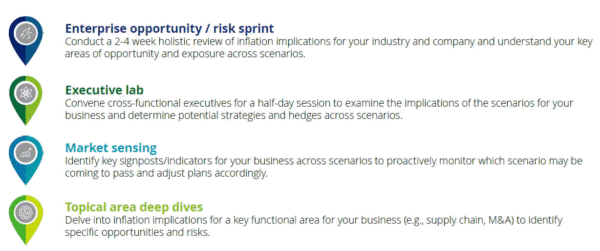The inflation outlook
June 8, 2022

US inflation is at its highest point in nearly 40 years. Here are scenarios for how inflation might evolve in the next three years and actions your organization can take to be resilient in each.
Inflation is creating widespread uncertainty
US inflation has reached its highest point in nearly 40 years, as the COVID-19 pandemic has caused both supply and demand-side shocks, with a disrupted supply chain, unprecedented levels of government fiscal stimulus, shifts in consumer spending, a decline in labor force participation, and persistent business uncertainty.
Inflation has been relatively low for so long that few US executives have managed organizations through periods of high inflation (or deflation). With little direct experience to guide them and growing uncertainty about what the future may hold, many executives are asking:
What can leaders do to prepare their organizations to be resilient no matter what the future of inflation holds?
In close collaboration with Deloitte’s US and global economists, we have identified four scenarios—stories about the future designed to spark insight and spot opportunity and risk—that describe different ways inflation could evolve between now and late 2024. For each scenario, we have also developed implications and recommendations for executives across key business areas.
Critical uncertainties
Four critical uncertainties are likely to impact the future of inflation in the US:
- How long will supply chain disruptions last?
- How do inflation expectations impact wage negotiations?
- How do consumer spending habits evolve?
- What is the nature of monetary policy?
In addition, the COVID-19 pandemic trajectory and potential downstream effects on the economy remain uncertain with the potential to contribute to inflationary pressures.
Four visions of the future
Four distinct scenarios emerge based on current trends and uncertainties, each with differing implications for US organizations:
Blue Skies: Current inflation is temporary and reverts to recent historical norms (~2%) as supply chain disruptions settle in 2022 and consumer demand for services vs. goods rebalances.
Sun Showers: Inflation settles at 3-4% through 2024 as supply chain disruptions persist and the labor supply remains somewhat constrained. Firms and consumers adjust, and growth continues, albeit unevenly across industries and players.
Stormy Weather: Inflation rises to 8-9% as inflation becomes embedded in worker expectations and a “wage-price spiral” takes off. A sluggish economy dampens both consumer and business spending.
Downdraft: Disinflation to 0-1% as a result of a faster than expected resolution of supply chain disruptions coupled with diminished consumer demand as “pandemic savings” are spent down.

Implications and actions
Each of these scenarios creates unique opportunities and challenges requiring business leaders to act responsively:
Blue Skies: Prepare for post-pandemic growth opportunities by going long on debt to invest in foundational capabilities and growth-oriented M&A. Increase enterprise resiliency by diversifying supply chains.
Sun Showers: Mitigate rising input costs and use performance improvement to invest in growth. Take advantage of inexpensive debt early on to disrupt weaker competitors or address current weaknesses to avoid disruption.
Stormy Weather: Focus on increasing efficiency and lowering risk through economies of scale and cost savings strategies (e.g., automation). Diversify business models and use financial hedges to mitigate risk of rising inflation.
Downdraft: Drive demand and emphasize value through new experiences and differentiated offerings. Rationalize suppliers and partnerships and consider restructuring to increase efficiency and savings.
The road ahead
All these scenarios are consistent with the data available at the end of 2021, and any of them could begin with CPI reports continuing to show high inflation into early 2022—even higher than we see today. The interplay between the evolving pandemic, the varied responses of Central Banks around the world and their near-term impacts, the evolution of public perception, and the possibility of other, yet-unknown shocks, makes it far too soon to presume the most likely course for inflation in 12, 24, or 36 months. Executives seeking to build resilience across these (or other) scenarios might consider various ways to identify specific options and risks:





























